Is Titanium Dioxide Dangerous?
The modernized world today is afflicted by an increasing amount of human health concerns both in number and variety of illness and disease present. Time Magazine references Paleolithic diet advocate, Loren Cordain, and his belief that our contemporary Western diet is what has provoked the emergence of “diseases of civilization” (13, 14). In fact, chronic diseases related to diet affect up to an estimated 65% of the population in Western cultures (13).
Much like many other environmental contaminants found in foods, titanium dioxide is a naturally occurring mineral. Although one may rebuke Cordain’s notion that foods today containing additives such as titanium dioxide have been found in our diets for much of history, researchers are becoming more cautious of recommending its safety for human consumption.

A “Naturally Occurring” Mineral
It is true that titanium dioxide is naturally found in nature. Unfortunately, this naturally occurring particle is a metal which is attracted to impurities. Manufacturers chemically process the mineral to remove impurities resulting in its white color, not to mention its newly produced synthetic form (11).
Its many applications in the manufacturing industry are a result of its absorbency, lack of odor, anticaking properties and whitening effects (8).
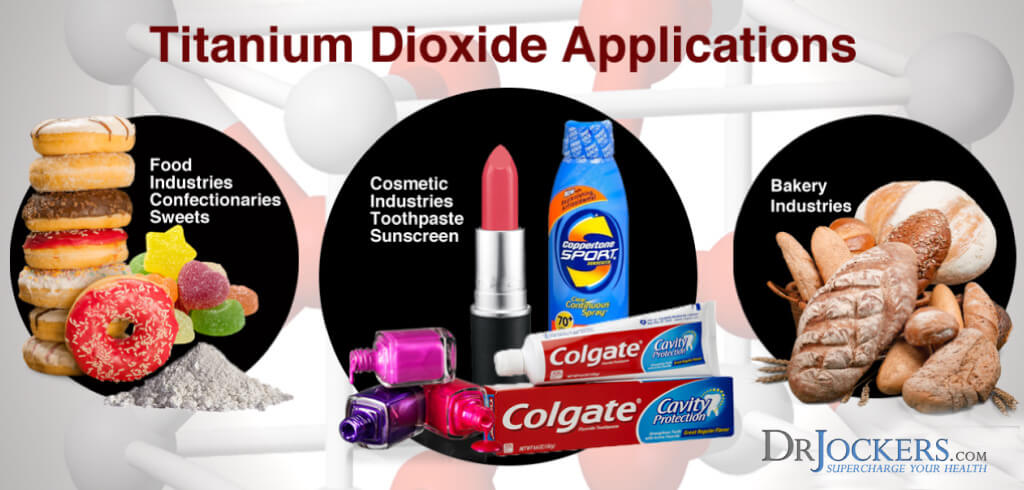
A Popular Additive
The greatest use for titanium dioxide in industries is its use as a pigment to color and thicken paints (11, 12). Titanium dioxide is also found in cosmetics such as sunscreen, over the counter oral products including supplements and medicines such as those in white tablet form, and lastly food products (3, 11). It is probably safe to say that you do not want to be consuming the same ingredients in your food as are also found in the paint on your kitchen walls. Correct?
You are exactly right to assume that titanium dioxide must have health consequences and should not be added to foods for consumption. Many organizations theoretically designed to protect the health of the public have ignored the possibility that titanium dioxide is a human carcinogen.

Who Protects Your Health?
The responsibility to remain an educated consumer is even more crucial today given the lack of leadership from agencies created to protect our health. After your read the following conclusions made by some of the health organizations regarding titanium dioxide, ask yourself if they have your same health interests in perspective.
International Agency for Research on Cancer (IARC): Although a Working Group with this agency believes that titanium dioxide is “possibly carcinogenic to humans” they cite “inadequate evidence” to classify the substance as carcinogenic (9, 12). Rather the IARC remains to list the substance as poorly soluble and a low toxicity particle despite an emerging body of evidence opposing this aged belief.
National Institute for Occupational Safety and Health (NIOSH): NIOSH acknowledges that titanium dioxide causes the most immediate threat when the metal is inhaled. In order to reduce risk for lung cancer and pulmonary inflammation, the agency simply recommends minimalizing exposure to this compound (8).
The organization’s scrutiny of titanium dioxide and its implications on human health raises further questions to be answered. For example, what happens to the particles when they reach the lungs? How are industries expected to control the exposure of these microscopic particles from being taken up into the air?
United States Food and Drug Administration (FDA): All too often the regulations and standards set by the FDA causes consumers to question its role within the Department of Health and Human Services. Perhaps those that embody the agency are also confused because they both categorize titanium dioxide as a “natural colouring agent” while also identifying the substances as “synthetically prepared” (3, 7).
Scientific literature supports that microscopic sized particles such as titanium dioxide are potentially hazardous to human health. Yet despite these warnings, the FDA regulates titanium dioxide as a GRAS substance. The agency remains to have only established concentration guidelines for manufacturer’s and does not require the ingredient to be listed on product labels. (3)
Even Dunkin Donuts recently removed titanium dioxide from their donuts due to concerns about the nanoparticle toxicity. Check out the story here
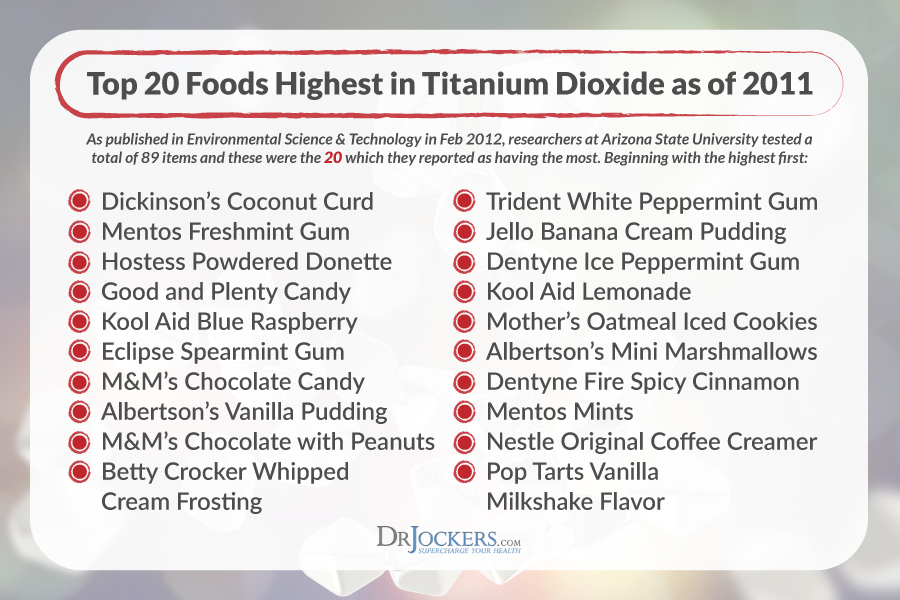 Titanium Dioxide Raises Health Concerns
Titanium Dioxide Raises Health Concerns
Removing titanium dioxide as a GRAS substance appears to illicit a negligible response from governing agencies as well as consumers. Understanding that the term “natural” is significantly misrepresented and even more so misunderstood may cause consumers a false sense of security in what we invest our hard earned money into.
Don’t fall for the trap and be aware of the health risks that titanium dioxide may expose.
Nanoparticle Exposure Creates Risks
Titanium dioxide has always been thought of as an inert particle with low toxicity and poor solubility (9). Coupled with the development of nanotechnology and the desire for manufacturers to make products look better, the potential exposure to nanoparticles is greater than ever before.
Consider the cluster of dust particles that may have just floated across your computer or phone screen as you read. One particle of dust can range from 3,000 to 9,000 nanometers (nm) in size. Now understand the harmful health implications that may be caused from exposure to nanoparticles distinguished at less than 100 nm in size. These particles may be even utilized in products in sizes of only 2-5 nm and have serious health consequences when digested. (10)
Why are such small sized particles used in the ingredients of products you ask? Sunscreen manufacturer’s use nano-sized titanium dioxide in no greater size than 50 nm because larger sized particles will remain visibly white and will not blend into the skin barrier (3). Would you wear sunscreen that made you appear ghostly following application?
The food industry produces products with a desired color to make goods more appealing to consumers. Although nano-sized titanium dioxide may be in small concentration, there presence alone may pose a significant carcinogenic hazard to human health.

Nanoparticles Increase Risk of Cancer
Although greater depth of studies need to be performed assessing the various factors in which nanoparticles create health complications, current evidence supports that nanoparticles pose enough of a health risk for such particles to be removed from products. Animals exposed to nanoparticles by various mechanisms such has inhalation, absorption through skin or ingestion, have increased risk of developing cancer in both the lungs and skin (9, 12).
Lacking in the scientific community is the understanding by which these nanoparticles become available and used in the body to promote cancer. A lack of understanding hardly seems like a justifiable reason as to why such particles are allowed for human consumption.

Titanium Dioxide Promotes Inflammation
Given the size of titanium dioxide particles as well as the electrical charge, exposure to the mineral has been linked to oxidative stress and chronic inflammation (3). An increase in oxidative stress in the body stimulates cellular and DNA damage.
Phagocytes are a type of defense cell that support the immune system by engulfing foreign and harmful bacteria and particles. Fine titanium dioxide particles are able to escape the immune system’s defense system of phagocytosis and are left available in the body to interfere with biological functions.
Exposure of titanium dioxide to cells has left researchers questioning how a series of harmful signaling pathways are created which promote inflammation. Findings indicate that an increase in ROS, or reactive oxygen species, directly correlates to the increase in cell proliferation, inflammation and uncontrollable cell death known as apoptosis. (3)
Titanium Dioxide Attracts Impurities
The ugly truth behind the potential carcinogen lurking in your food does not stop with health risks linked to titanium dioxide. Titanium Dioxide can be coated with other materials such as silica, zirconia, magnesia and aluminum (3). Again, the FDA does not regulate within the manufacturing industry the purity of titanium dioxide or the synthetic materials used to coat the mineral.
The FDA also specifies in their Code of Federal Regulations for titanium dioxide that there is an accepted concentration of lead, arsenic, antimony and mercury allowable in foods containing the likely carcinogen (7). You probably didn’t have enough to concern yourself with.
A recent study analyzed the toxic effects of silica and titanium dioxide particles in cells and found that the particles are capable of altering gene expression and such microscopic sized particles can permeate the brain and an animal’s placenta (4). This evidence creates further concern regarding such additives to be found in food given the unknown effects it may have on a developing fetus and inflammatory consequences it may have on brain tissue resulting in abnormal brain activity.
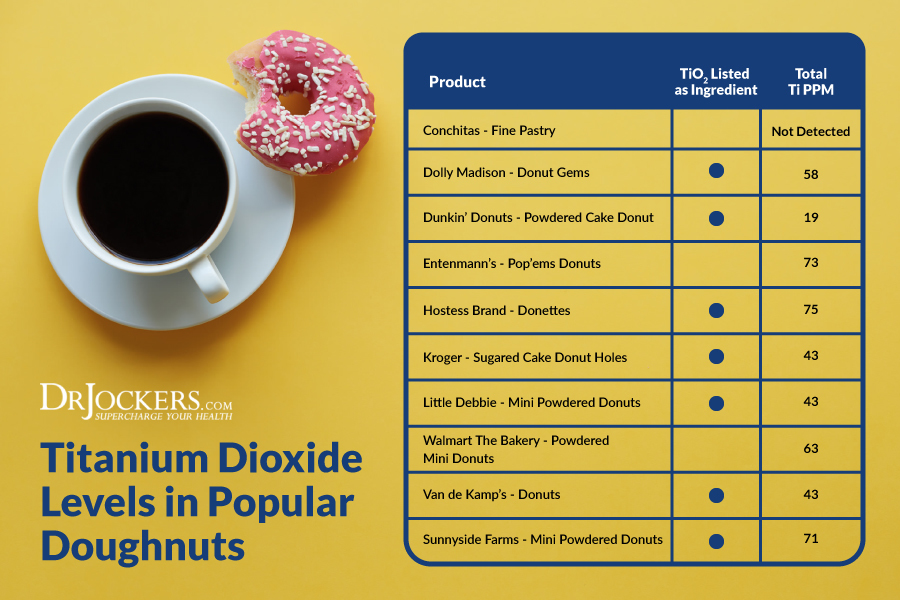
Titanium Dioxide Damages the Gut Lining:
Animal studies have found that titanium dioxide particles are capable of being exchanged along the gastrointestinal tract. Storage of titanium dioxide has been found in various organs including the liver, spleen, kidneys and lung tissue. (5)
Contrary to the largely accepted belief that ultrafine particles such as titanium dioxide are inert, research indicates otherwise. It can significantly devastate the immune system as a consequence of its ability to permeate the intestines.
The susceptibility of titanium dioxide to sneak through the gastrointestinal tract poses a significant health risk to individuals with gut sensitives such as Crohn’s disease and ulcerative colitis. Titanium dioxide represents only one of a concerning 10 different types of microparticles estimated to be consumed daily in a Western diet. (6)
PAD and Chronic Inflammation:
Chronic inflammatory conditions accelerate the development of disease and cancer. Greater evidence is continuing to emerge identifying the intricate interaction our immune system has in signaling pathways which may either promote or prevent an inflammatory response (2, 3). Carcinogenic additives in food may lead to the development of autoimmune diseases such as rheumatoid arthritis.
The presence of a protein known as PAD (peptidylarginine deiminase) appears to be induced when in the presence of titanium dioxide particles. PAD is present in cellular conditions exhibiting increased oxidative stress and inflammation. (2)
A growing body of evidence supports that 500 nm sized titanium dioxide particles (at least 5 times larger than the size of nanoparticles also found in food) can be absorbed through the gastrointestinal tract and stored in organs such as the liver and spleen. Smaller particles ranging from 80 nm to 155 nm had detectable damage to not only neighboring organs of the digestive tract but also to the brain. (3)
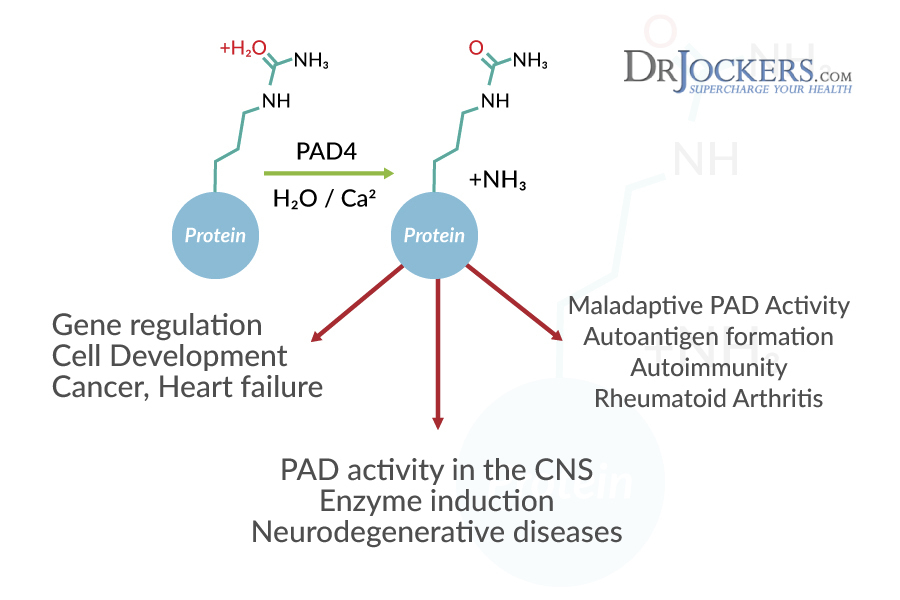
Concern for Long Term Effects
You may recall the term “bioaccumulation” or “biomagnification” from your environmental science class in school or from a recent complaint from your child opposing their desire to eat tuna fish.
Bioaccumulation is the increase in concentration of a toxin in an organism received from the environment whereas biomagnification refers to the buildup of a pollutant within a food chain. Both problems represent a potential threat to human health and pose another risk concern regarding this compound.
Problems concerning titanium dioxide in our food supply arise from several uncertainties and studies have not been performed assessing the effects of titanium dioxide on long term human health. If the particles do in fact become biologically available to the body, researchers must seek to understand the following concerns:
- What are the biological pathways in which titanium dioxide is taken up in the body including inhalation, absorption and ingestion?
- How much of the particle is stored in our bodies or excreted?
- How prevalent is titanium dioxide in food products and at what daily concentration is allowable before there is any notable damage to either cells or body functions?
- What size particle, if any, can the body safely remove?
- What biological pathways are the synthetic coatings on the additive interfering with and its health impact?

Titanium Dioxide and Our Food Supply
Titanium dioxide is a contaminant of the aquatic ecosystem both naturally as well as due to human interference. Just think of the cloud of sunscreen that swirls around you as you float away with the ocean current. Fish cells are more susceptible to the accumulation of toxins into their tissue than are your body’s own cells and this accumulation creates cell damage and fatality in fish (3).
The accumulation of toxins in fish cells and tissue then becomes your problem every time you sit down to enjoy your seasonal favorite meal of rainbow-trout, for example. If it is a possible carcinogen which accumulates in the human body, you will undoubtedly increase the concentration of this toxin with this meal.
The concern for long term effects of titanium dioxide is well justified and the consumer should be the only individual responsible in deciding if the potential health dangers are worth eating foods containing the additive.
Foods Containing Titanium Dioxide
Take a look at products that commonly contain the additive in your fridge. Find titanium dioxide listed on the ingredients of any of the following items that commonly contain the additive. (1, 3)
- Cottage, cream and processed cheeses
- Condiments including mayonnaise, mustard, horseradish cream, and vinegar
- Nut spreads such as almond or peanut butter
- Desserts such as custard, tapioca pudding, sherbet or sorbet
- Sausages
- Processed deli meats
- Confectionery sugar
- Canned fish products
- Dairy drinks including chocolate milk, eggnog, kefir or whey-based drinks
- Prepared foods such as potato and macaroni salad, and foods containing battered fish or poultry
- Energy drinks labeled as “sport,” “energy,” or “electrolyte” beverages with a water base
- Processed snacks like Twinkies and powdered donuts
- Although not a food, many oral supplements contain the filler

Good Manufacturing Practices:
How many ingredient labels did you find list titanium dioxide as an added ingredient? Recall that the FDA does not require the labeling of titanium dioxide in any of its products. If the manufacturer does choose to list the additive, it is likely labeled as “E171” amongst the list of added ingredients. The FDA only sets standards regulating that the potentially toxic additive can be added to foods in up to concentrations of 1% of the weight of the food. (3)
Good manufacturing practices seem to be a matter of perspective when it comes to regulating the actual quality and nutritional content contained in food. The FDA has yet to address other concerning factors such as the size or purity of the substance.
Titanium Dioxide in your Body?
Think back to the last time you may have been lied to or someone did not disclose the full truth to you. From your experience, does the lack of disclosure typically indicate that someone may not have your best interest at heart?
If industries including food, cosmetic and drug companies do not desire to list titanium dioxide in their list of ingredients, do you want it in your body?
Your answer may change how you eat, how you shop and who you purchase quality products from. Understanding that food most closely identifiable from its original source is most beneficial for your health. Choose local and trusted farmers and markets to purchase products with the highest quality and standards to minimize your exposure to another potential human carcinogen.
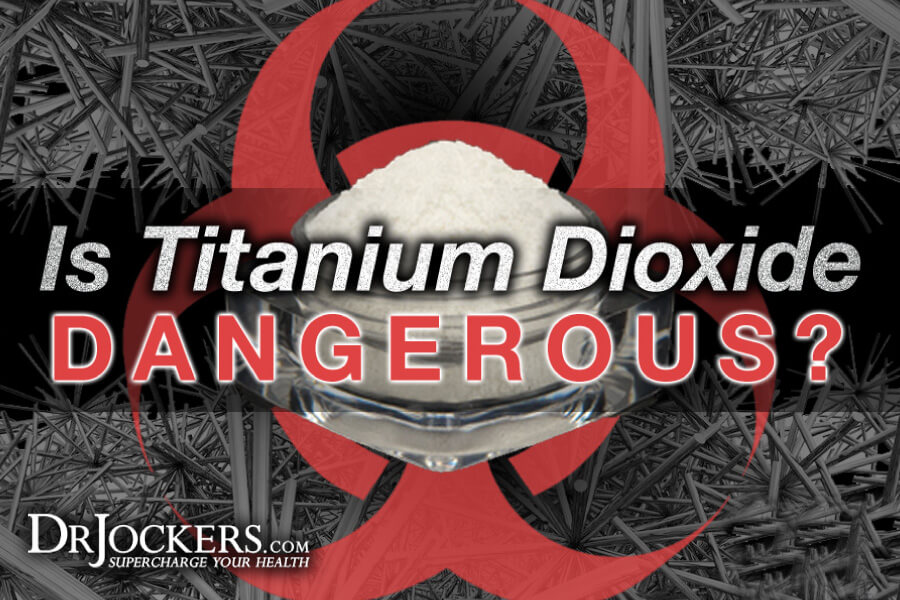
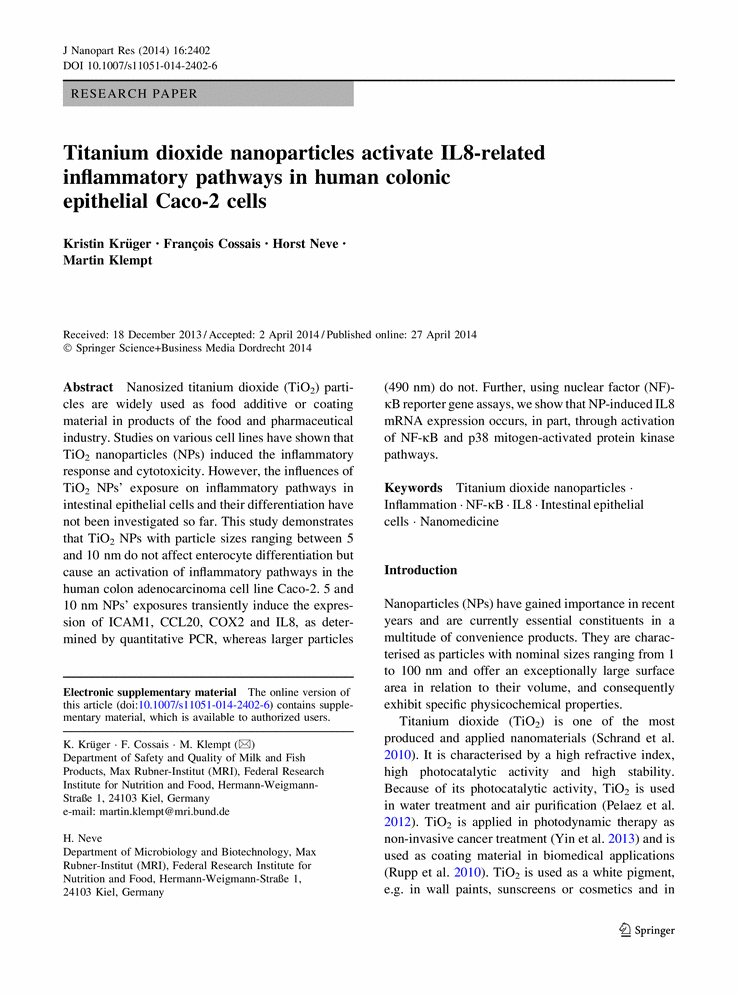






Doc how do we remove titanium dioxide, does anyone have a clue?
Stop consuming it and follow the strategies here: https://drjockers.com/improve-detoxification-system/
Titanium dioxide is very stable chemical compound. I can not imagine how to remove it easily from our body, so I agree with Dr. Jockers. We can only hope to find some unexpected way like with cilantro and mercury.
Yes, this BioToxin Binder can help the body to eliminate it https://store.drjockers.com/products/biotoxin-binder
Why does your product, BioToxin, have nano sized polyelectrolytes in it? Nano is used with Titanium Dioxide and is part of the toxic problem.
Nano sized molecules aren’t a problem in and of themselves. If the nanoparticles are strengthening or restorative for cells it is great. If it is toxic, then it is a problem. Everytime we eat food, we are consuming nanosized particles. The Bioactive carbon products have nano sized polyelectrolytes that help to improve the electrical charge of cells so they can function more effectively and it pulls them out of the cell danger response. Nano sized particles of titanium dioxide are a problem because they can easily penetrate and poison the cells.
What about a sewing machine with a warning on titanium dioxide, would it be safe to use or consider another machine?
I am not sure, perhaps it is off gasing the titanium dioxide. In which case, I would consider a different machine.
I am retired and have time on my hands to research and investigate all of the horrible additives the FDA and other agencies (that are supposed to be protecting our foods) are allowing to be used in everything. It is sooo scary. Artificial sweeteners scare me the most. They are sneaked into thousands of items. Recently, I picked up my granddaughter’s allergy medicine, only to find it contained Splenda. I contacted the pharmacy and was informed it is in all liquid forms of allergy meds for children. We immediately visited her Dr. and she was prescribed a pill form. In my opinion the FDA is useless. WE have to take control of all aspects of our lives and do our own research and investigations on everything….so sad and it is all related to MONEY. Just saying.
Yes it is very true!! Thanks for sharing Donna!
I AM RESEARCHING VITAMINS/SUPPLEMENTS FOR HAIR, SKIN, AND NAILS. ONE OF THE LEADING SELLERS IN OUR COUNTRY, NATURES BOUNTY, USES TITANIUM DIOXIDE “COLOR”. IT DOES NOT SPECIFY THE ACTUAL QUANTITY? (I USE NATURES BOUNTY FOR SEVERAL SUPPLEMENTS AND BELIEVE THEY ARE A QUALITY COMPANY WITH GOOD QUALITY PRODUCTS.)
WHAT ARE YOUR THOUGHTS ON THIS AND THE POTENTIAL TOXICITY BASED ON NB’s USE FOR COLOR ONLY?
(WILL I RECEIVE AN EMAIL REPLY OR NOTIFICATION THAT A RESPONSE IS WRITTEN?)
Yes absolutely you want to avoid any supplements with titanium dioxide.